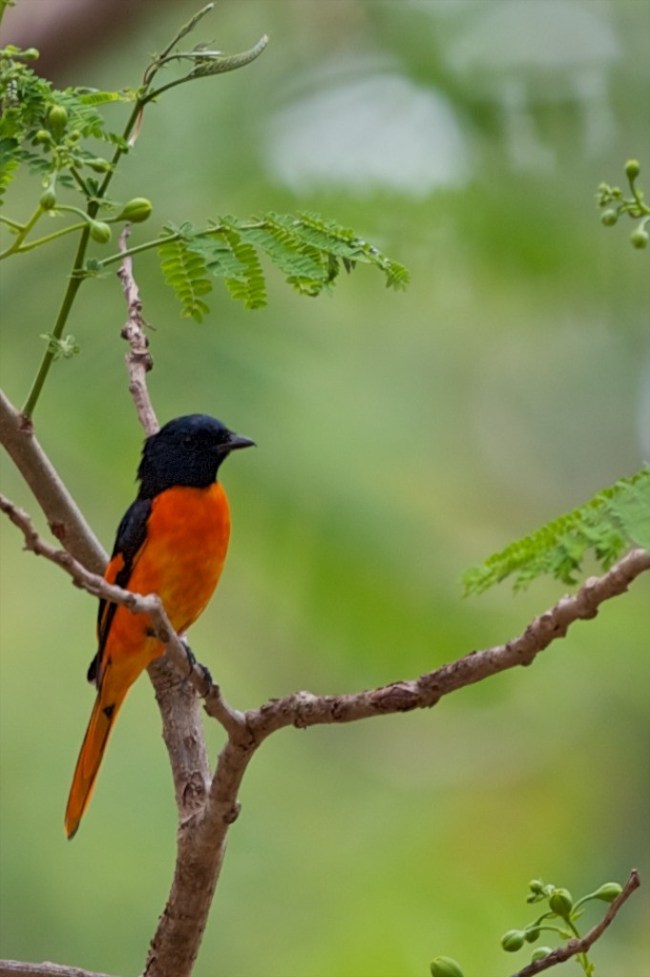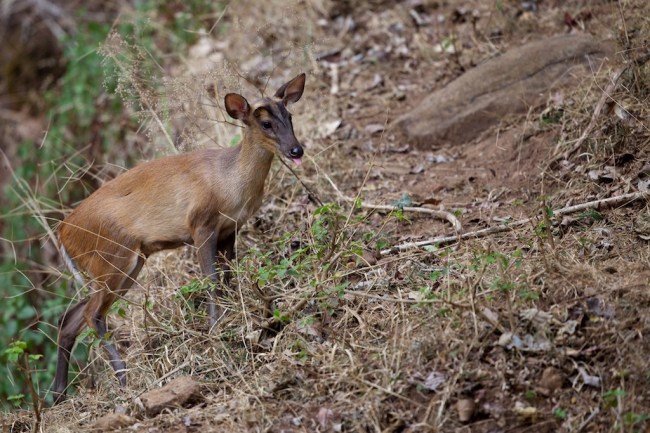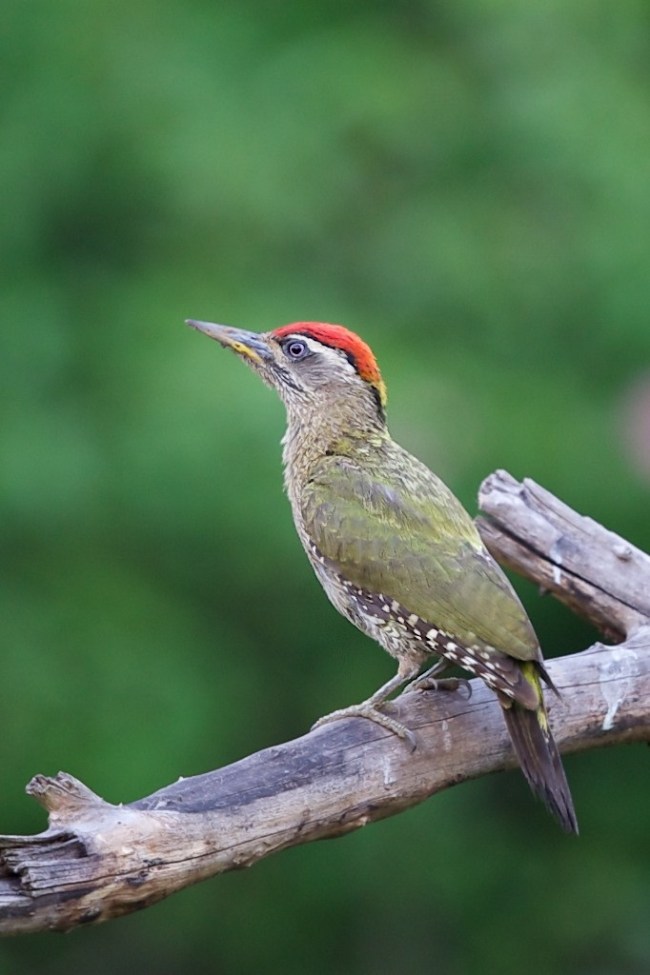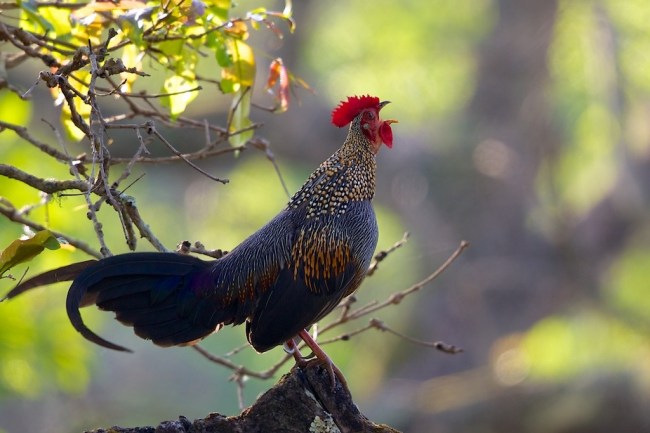Trip Report: BRT Tiger Reserve
Bandipur National Park
Dates: 1-3 May 2014
Camp: JLR’s K. Gudi Wilderness Camp & Bandipur Safari Lodge
All the photographs used in this post were shot by S. Balajee.
I was supposed to do KMTR this weekend with GK. Unfortunately he fell ill and we abandoned the plan at the last moment. I was however able to tag along with my sister’s family on this trip. We did one night and two safaris each at BR Hills and Bandipur. The two-destination idea turned out to be quite productive, adding variety without being inconvenient as Bandipur is a short 70 kms from K Gudi.
BRT TR/K. Gudi
Reaching the camp by 11:30 AM gave us opportunity for some pre-lunch birding, in the camp and around the little lake by it. We saw Cinereous tit, Magpie robin, Common myna, unidentified warbler, Asian brown flycatcher, Orange minivet, White-browed wagtail, Red-rumped swallow, Red-whiskered bulbul, Gold-fronted leaf bird, White-cheeked barbet, Jungle babbler, Brahminy kite, Oriental white-eye, Black hooded oriole, unidentified flameback and Spotted dove. And the Black eagle.
On my wish-list for this visit were four stars – Black eagle, Red spurfowl (don’t ask why), Rufous babbler (with a photo-op) and Southern tree shrew – and possibly an elephant mock charge as icing on the cup-cake. The first of these – the Black eagle – was knocked off the list within an hour of reaching camp. And this is not the first time I’ve seen this raptor over the K. Gudi camp.
Gold-fronted leaf bird:
Orange minivet, male:
Cinereous tit:
Incidentally, we stayed in the Biligiri and Nilgiri log huts, farthest down the line and abutting the jungle. I had referred to the Biligiri log hut in my previous K. Gudi trip report post.
The first safari was naturally the evening one. The weather was surprisingly cool and cloudy, a welcome change from the dry, sweltering furnace that was Bangalore. On my last visit, we had an extremely productive time with birds thanks to us being driven on safari by Rajesh. We asked for him this time too and Prasad, the new manager was kind enough to oblige. Rajesh has razor-sharp eyesight, spotting skills like you wouldn’t believe, and is a mustard-keen birder. A worthy successor to Thapa, the legendary driver/spotter of K. Gudi, now retired. With Rajesh, his bins and his copy of Grimmett & Inskipp along, there was not a dull moment on safari. And the forest was fairly throbbing with birdlife despite the time of year.
Barking deer, fawn:
The evening was therefore pleasant enough, with some involved birding. Early into the safari we found a pair of Racket-tailed drongos mobbing a Jungle owlet. These drongos were ubiquitous.
Racket-tailed drongo:
Fairly common also was Magpie robin, Indian blackbird, Jungle myna, Jungle babbler, Bronzed drongo, Indian treepie, Grey junglefowl, Common hawk cuckoo, White-bellied drongo and bulbul (both Red-vented and Red-whiskered).
Rajesh had marked a burrow in the earth tenanted by a Blue-bearded bee-eater and we spent some time watching the bird flit in and out. Both Rajesh and BIL B were keen on getting a picture of the event, but this posed a challenge as getting close enough for a clear line of sight was deterring the bird – although the nest was just off the road and barely a foot off the ground.
Blue-bearded bee-eater:
Other notables were Indian pitta (two separate sightings), Malabar whistling thrush, Green imperial pigeon, Orange-headed thrush, Oriental honey buzzard, Crested serpent eagle, Brown fish owl and Rufous babbler (second item off the wishlist). The much-awaited mock charge didn’t materialize, but we did see a trio of elephants in high grass.
Brown fish owl:
Waking up in camp the next morning to the calls of Jungle owlet, Indian Nightjar, Common hawk cuckoo, Black-hooded oriole, Magpie robin, Hoopoe, and Tufted langur, we set off on what turned out to be a sparkling safari.
Black-hooded oriole:
Common hawk-cuckoo:
We found a quartet of Nilgiri wood pigeons fluttering about a salt lick and spent some time there. We then ran into a Mountain imperial pigeon and the day was starting to look better and better. Red spurfowl went off the wishlist next, although the sighting was a tad too fleeting for comfort. That left just one worthy on the list – the Southern tree shrew.
And as luck would have it, we found a pair of these rodents gamboling on the grass and on a fallen tree, in the open, not very far away, and in perfect light. Of such moments is paradise made. BIL B got a bunch of very decent pictures, and I got a good clear look at Anathana ellioti. Suum cuique!
Southern tree shrew:
Bandipur
The evening safari started off with a spot of rain but this quickly subsided, leaving the jungle cool and glistening. This was a typical Bandipur safari, with plenty of flamebacks and intrepid Stripe-necked mongooses. If BRT is the place for Barking deer that aren’t human-shy, Bandipur is the place for Stripe-necked and Ruddy mongooses.
Stripe-necked mongoose:
Passing by the Anekatte waterhole, Kiran the driver thought he spotted a ‘brown shape’ disappearing into some shrubs, and we stopped there waiting. In a while, someone at the back of the jeep realized that there was an elephant standing just off the road and about seventy meters behind us. It turned out to be a magnificent makhna, and we rolled the jeep back a short way to watch this distraction. The elephant was not too happy with the situation, and showed signs of restless agitation. But he wasn’t sure what do to about it either. Turn tail and flee, or get all belligerent and nasty. And so he kicked his feet, threw dust over himself, stamped around, swayed and did a bunch of things to express his annoyance.
After a while, we decided to leave him to his devices and started up again, stopping briefly by the pool to confirm that the brown shape hadn’t materialized while we weren’t looking. It had not, and off we went. Later on in the safari, we saw another herd of four elephants at some distance.
Sambar hind:
The next morning was better. We entered the forest not by the usual gate right across the road from the reception center, but from the turn-off further down the road, towards the congregation of resorts. A couple of oncoming vehicles reported the presence of dhole further up the road. Passing by a massive herd of chital some hundred strong, we heard alarm calls and stopped. A lone, unseen sambar stag to our right responded with his own belling honk. Scan as we might with binoculars, nothing was visible and the calls presently subsided. This herd was within the perimeter of the camp, with buildings not very far away. Concluding that a snake was the probable cause of all the commotion, we moved on to look for Cuon Alpinus.
The pack came into view in a short while, with the remnants of a chital kill by the road. The dogs had demolished the carcass and were lying around worrying the larger bones when we appeared on the scene. One by one they took themselves off, pausing to stare at us before pattering into the thickets without showing undue haste. We counted six dogs in the pack. The morning light was fine and mellow, and BIL B got some impressive pictures.
Indian wild dog or dhole:
Much later in the safari, we passed by an anti-poaching camp (APC) and a while later, ran into a JLR safari van driver who had news of a tigress kill near this APC. K-turning back, we found what was left of the kill (a sambar hind) hidden just by the road. A lone jungle crow that was making the most of the opportunity and a waiting safari van pointed us to the spot. We waited for a short while before concluding that the tigress had possibly decamped after consuming the kill.
Streak-throated woodpecker:
I made a start with jungle trees during this safari. Six trees were most commonly seen on this route and I learned to ID the ones I earlier couldn’t. Flame of the forest (Butea monosperma), the Crocodile bark tree or kari mathi (Terminalia tomentosa), Axlewood tree (Anogeissus latifolia) with its pale, guava-like bark and clustered, drooping leaves, Indian gooseberry (Phyllanthus emblica) with its fern-like foliage, and teak (Tectona grandis). The sixth I haven’t been able to relate to; Kiran used the local term Jaaldar for it. This is a small-to-medium sized tree, vaguely reminiscent of Tabebuia aurea/argentea. I have photographs and should be able to take someone’s help to ID it in a day or two.
Not having paid more attention to trees in BRT TR too was a pity, and I should spend some effort on trees in upcoming trips.
Grey junglefowl, cock:
Black-naped hare:
The List:
BRT TR
Avifauna:
- Asian brown flycatcher
- Asian fairy bluebird
- Black-hooded oriole
- Black kite
- Blue-bearded bee-eater
- Brahminy kite
- Bronzed drongo
- Brown fish owl
- Cinereous tit
- Common hawk cuckoo
- Common myna
- Coucal
- Crested serpent eagle
- Flameback (?)
- Flowerpecker (?)
- Gold-fronted leaf bird
- Green imperial pigeon
- Grey junglefowl
- Hill myna
- Hoopoe
- Indian blackbird
- Indian cuckoo (calls)
- Indian nightjar (calls)
- Indian pitta
- Jungle babbler
- Jungle myna
- Jungle owlet
- Large cuckoo shrike
- Magpie robin
- Malabar whistling thrush
- Mountain imperial pigeon
- Nilgiri wood pigeon
- Orange-headed thrush
- Orange minivet
- Oriental honey buzzard
- Oriental white-eye
- Pigmy woodpecker
- Plum-headed parakeet
- Racket-tailed drongo
- Red-rumped swallow
- Red spurfowl
- Red-vented bulbul
- Red-whiskered bulbul
- Rufous babbler
- Spotted dove
- Warbler (?)
- White-bellied drongo
- White-browed wagtail
- White-cheeked barbet
- White-throated kingfisher
Mammals:
- Barking deer
- Elephant
- Gaur
- Malabar giant squirrel
- Southern tree shrew
- Spotted deer
- Tufted langur
- Wild boar
Others:
- Terrapin
Bandipur
Avifauna:
- Asian paradise flycatcher
- Bay-backed shrike
- Brahminy starling
- Bushlark (?)
- Common hawk cuckoo
- Coucal
- Flameback
- Grey junglefowl
- Hoopoe
- Indian cuckoo (calls)
- Jungle babbler
- Jungle myna
- Magpie robin
- Peafowl
- Pied bushchat
- Plum-headed parakeet
- Red-wattled lapwing
- Shikra
- Spotted dove
- Streak-throated woodpecker
- White-bellied drongo
- White-breasted waterhen
- White-browed fantail
- White-throated kingfisher
Mammals:
1. Barking deer
2. Dhole
3. Elephant
4. Gaur
5. Sambar
6. Stripe-necked mongoose
7. Tufted langur
8. Black-naped hare
















